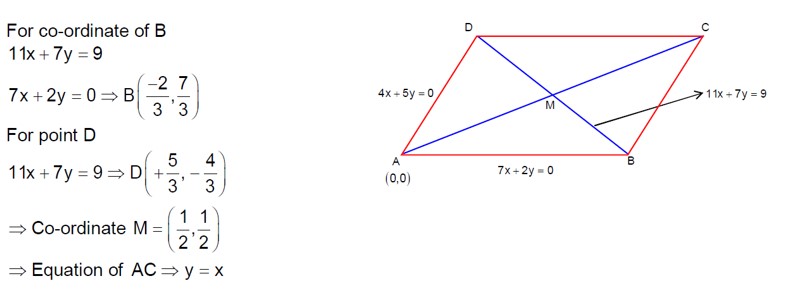Maths NCERT Exemplar Solutions Class 11th Chapter Eleven
Get insights from 151 questions on Maths NCERT Exemplar Solutions Class 11th Chapter Eleven, answered by students, alumni, and experts. You may also ask and answer any question you like about Maths NCERT Exemplar Solutions Class 11th Chapter Eleven
Follow Ask QuestionQuestions
Discussions
Active Users
Followers
New answer posted
3 months agoContributor-Level 10
f' (x)=g (x)
f" (x)=g' (x)
⇒g (x).g' (x)=f' (x).f" (x)
f (x) has five roots
⇒f' (x) has atleast 4 roots.
And f" (x) has atleast of 3 roots
⇒g (x).g' (x)=0 has atleast 7 roots in (a, b)
New answer posted
3 months agoContributor-Level 10
General form Σ? ? C? (1/2)? < 1/2
Σ? ? C? < 2?
⇒? C? +? C? +.? C? < 128
⇒256− (? C? +? C? +.? C? ) < 128
⇒? C? +? C? +.? C? > 128
n≥5
New answer posted
3 months agoContributor-Level 10
p: there exist M>0
Such that x≥M for all x∈S
Obviously ~p: M>0 such that x
New answer posted
3 months agoContributor-Level 10
Any point on line (1)
x=α+k
y=1+2k
z=1+3k
Any point on line (2)
x=4+Kβ
y=6+3K
Z=7+3K?
⇒1+2k=6+3K, as the intersect
∴1+3k=7+3K?
⇒K=1, K? =−1
x=α+1; x=4−β
⇒y=3; y=3
z=4; z=4
Equation of plane
x+2y−z=8
⇒α+1+6−4=8 . (i)
and 4−β+6−4=8 . (ii)
Adding (i) and (ii)
α+5−β+12−8=16
α−β+17=24
⇒α−β=7
New answer posted
3 months agoContributor-Level 10
Lt? →? x/ (1−sinx)¹/? − (1+sinx)¹/? )
= 2x/ (1−sinx)¹/? − (1+sinx)¹/? ) Multiply by conjugate
= 4x/ (1−sinx)¹/²− (1+sinx)¹/²) Multiply by conjugate
= 8x/ (1−sinx−1−sinx) Multiply by conjugate
= 4x/sinx = −4
New answer posted
3 months agoContributor-Level 10
[3¹/²]^ (log? (25? ¹+7)+ [3¹/? ]^ (log? (5? ¹+1) = 180
⇒ 45 (5²? ²+7) / (5? ¹+1) = 180
⇒ (5²? ²+7)/ (5? ¹+1) = 4
Put 5? ¹=t
⇒ (t²+7)/ (t+1) = 4
⇒ t²−4t+3=0
⇒t=1,3
⇒5? ¹=1 or 5? ¹=3
⇒x=1 or x−1=log?3
New answer posted
3 months agoContributor-Level 10
S? : |z−2|≤1 is circle with centre (2,0) and radius less than equal to 1.
S? : z (1+i)+z? (1−i)≥4
Put z=x+iy
y≤x−2
Solving with S1
⇒x=2−1/√2, y=-1/√2
Point of intersection P= (2−1/√2, −i/√2)
|z−5/2|² = | (2−1/√2)−i (1/√2)−5/2|² = (5√2+4)/4√2 = (5+2√2)/4
New answer posted
3 months agoContributor-Level 10
α=max {2? sin³?2? cos³? }
=max {2? sin³? 2? cos³? }=2¹?
β=min {2? sin³?2? cos³? }=2? ¹?
α¹/? +β¹/? = b/8
⇒4+1/4 = b/8
⇒17/4 = b/8 ⇒ b=-34
Again α¹/? β¹/? =c/8
⇒4*1/4 = c/8
⇒c=8
⇒c−b=8+34=42
New answer posted
3 months agoContributor-Level 10
A? =B? (i)
A³B²=A²B³. (ii)
Subtract (i) & (ii)
⇒A³ (A²−B²)=B³ (B²−A²)
⇒ (A²−B²) (A³+B³)=0
A²−B² is invertible matrix
∴A²−B²≠0
⇒A³+B³=0
∴? A³+B³? =0
Taking an Exam? Selecting a College?
Get authentic answers from experts, students and alumni that you won't find anywhere else
Sign Up on ShikshaOn Shiksha, get access to
- 66k Colleges
- 1.2k Exams
- 680k Reviews
- 1800k Answers

